How to Develop and Integrate Route Optimization Into a Software Product

With fuel prices soaring, delivery costs are inevitably rising, impacting demand for goods and causing a drop in revenue and profit for the delivery industry. For instance, 35% of logistics companies reported a substantial decrease in orders when fuel prices rose, with 12% saying orders dropped by 25%, according to the 2022 study by the business group Logistics UK. This pushes logistics providers to pursue route planning software development to reduce transportation costs and outstrip the competitors.
A custom vehicle route optimization solution can help businesses optimize and easily manage their fleet routes. By saving time, mileage, and resources, logistics companies can maintain their delivery prices, keep customers satisfied, and increase their bottom line.
Read also: 8 Latest Logistics Trends in Supply Chain Management
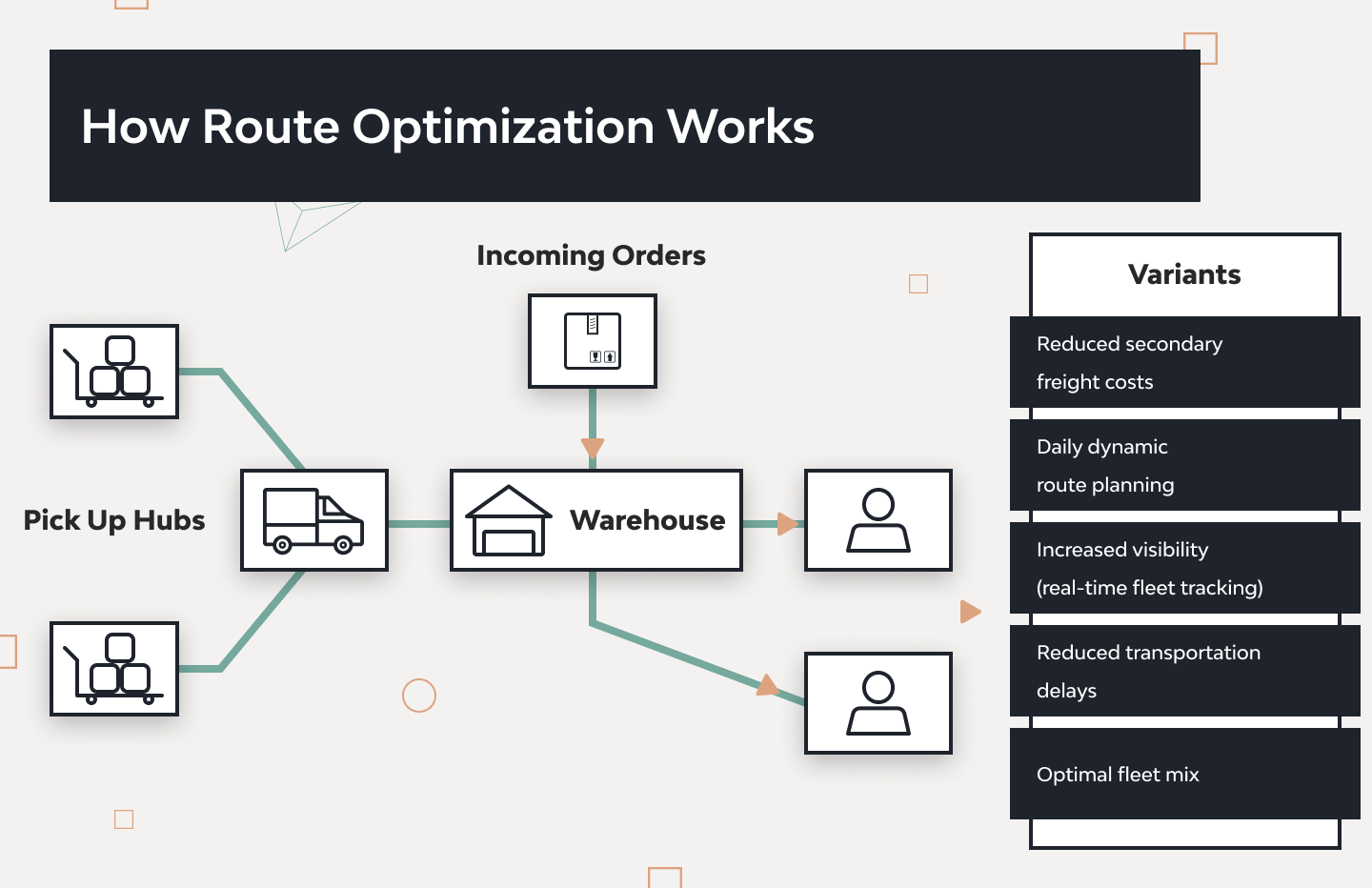
Our example is a US logistics company that executes orders across various locations (physical addresses, warehouses, and hubs). This means that route optimization is critical for them to improve the speed and quality of orders. One of the app’s modules, developed by Django Stars, allows for planning an optimal route (solving the traveling salesman problem) and distributing the workload among drivers. We have repeatedly used this module in the process of providing logistics software development services. The system also takes into account variables like new or canceled orders, scheduling problems, and vehicle dimensions to create the best routes.
The decision to develop custom vehicle route optimization software isn’t easy to make, especially without sufficient information about the process and its outcomes. That is why we gathered the benefits, must-have features, and peculiarities of adopting optimized route planning to gain a competitive edge.
How Route Planning Solutions Enhance Logistics Processes
Transportation route optimization software helps plan time- and fuel-efficient routes based on the factors like the number and location of stops, arrival/departure time gaps, and loading/unloading time, to name a few. The latest studies forecast that the market for route optimization software will grow at a CAGR of 10.9% over the next five years. And for very good reasons.
Route scheduling optimization software helps companies reduce spending and minimize delivery network bottlenecks. Here’s how.
Decrease maintenance costs
Route optimization software considers the weight and volume of deliveries to ensure optimal distribution and capacity utilization. This reduces excessive mileage and helps minimize vehicle strain, lowering maintenance costs.
Contribute to a greener logistics
40% of all road transport emission comes from freight transportation (lorries and trucks). Route planning software can reduce the carbon footprint by optimizing routes for the trucking industry. For example, it can calculate the most efficient route and plan deliveries according to proximity and truck capacity, making sure trucks don’t go out half-empty. This lowers the number of trucks on the road, which, in turn, lowers fuel consumption and CO2 emissions.
Discover fleet-related insights
Software for transportation route optimization provides insights into an entire fleet’s performance on the road, including delivery patterns and resource usage. The software can track many essential performance metrics, like mileage, drive times, load and unload times, fuel consumption, and vehicle maintenance. Thanks to it, businesses can see where there’s room to improve their key performance indicators (KPIs) and how they might allocate resources better.
But route optimization software does much more than solve basic vehicle routing problems (VRPs), including capacitated VRPs, pickup and delivery VRPs, and VRPs with time constraints. Let’s look at its many capabilities.
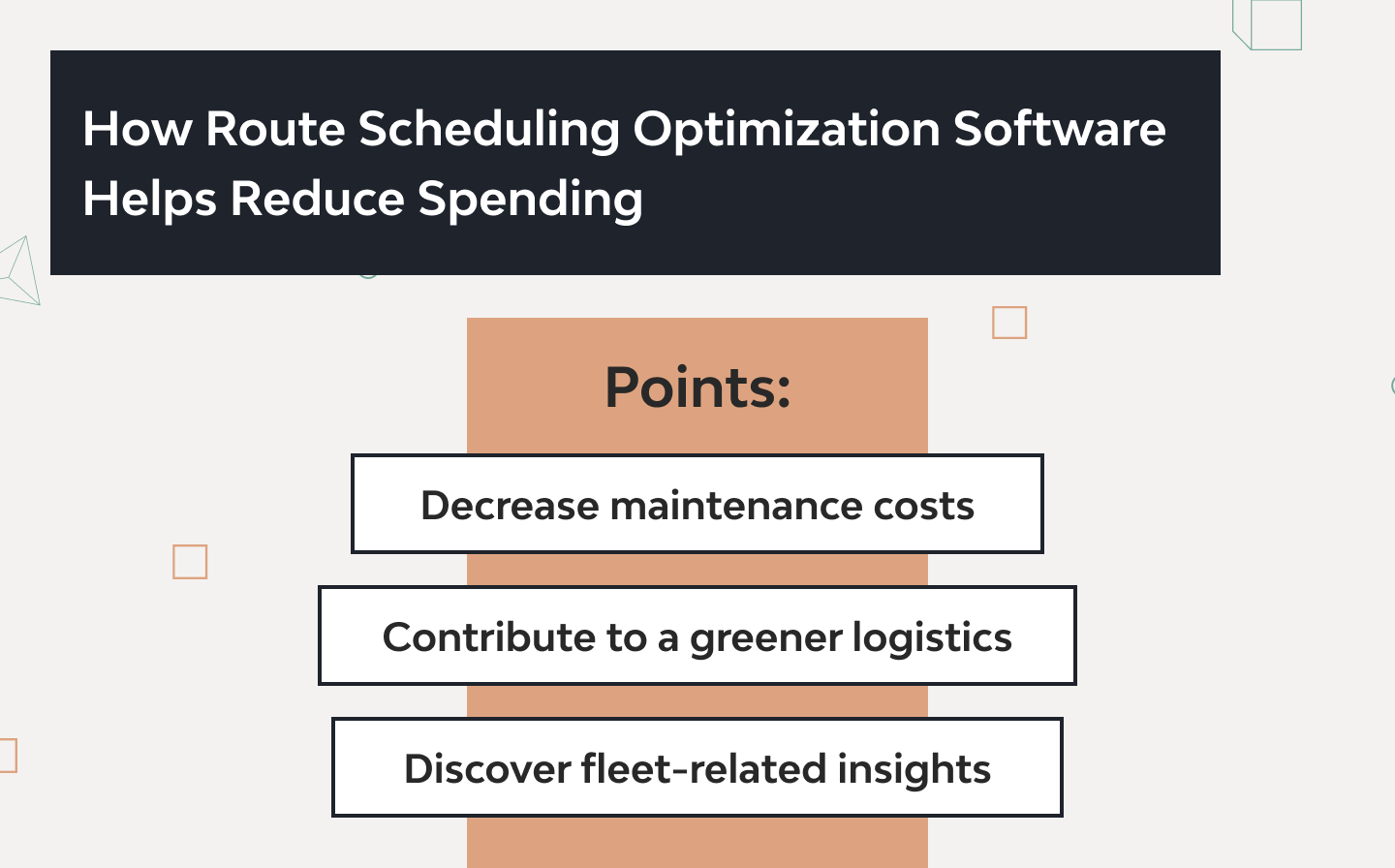
Benefits of Vehicle Route Optimization Applications
Route scheduling solutions address the typical optimization issues to bring transportation companies the following benefits.
Automated planning
In 2021, European cargo trucks traveled 21.2% of their distance empty — that amounts to 21 billion miles or 34 billion kilometers. This leads to inefficient vehicle usage and more fuel expenses for carriers. Custom vehicle routing software minimizes the deadhead mileage problem by ensuring the efficient distribution of deliveries across vehicles.
Painless rerouting
Software for transportation route optimization can dynamically recalculate routes based on real-time traffic information, accounting for accidents, road closures, weather, and other unforeseen events. This allows drivers to quickly adapt their journey based on road circumstances and new delivery requirements (e.g., changed time or address).
Improved fleet management
Thanks to GPS tracking, route optimization software can give real-time visibility of vehicles’ locations, allowing for effective fleet monitoring and management. The software also assists in assigning drivers to routes, taking into account factors like driver availability, driving category, and workload balancing.
Effective problem solving
Route planning software development can handle constraints such as delivery time windows, vehicle capacities, customer preferences, and special instructions. Managers can set up rules and exceptions that allow the software to send alerts and notifications about missed deliveries, failed pickups, delays, or route deviations. This way, managers can act fast and intervene immediately.
Automated reports
Custom vehicle routing software can automatically generate comprehensive reports and provide analytics on key performance indicators such as delivery time, distance traveled, fuel consumption, and driver productivity. This saves managers’ time and effort and facilitates real-time decision-making.
If all these perks of adopting a route optimization solution sound tempting, let’s see what’s involved in developing a solution.
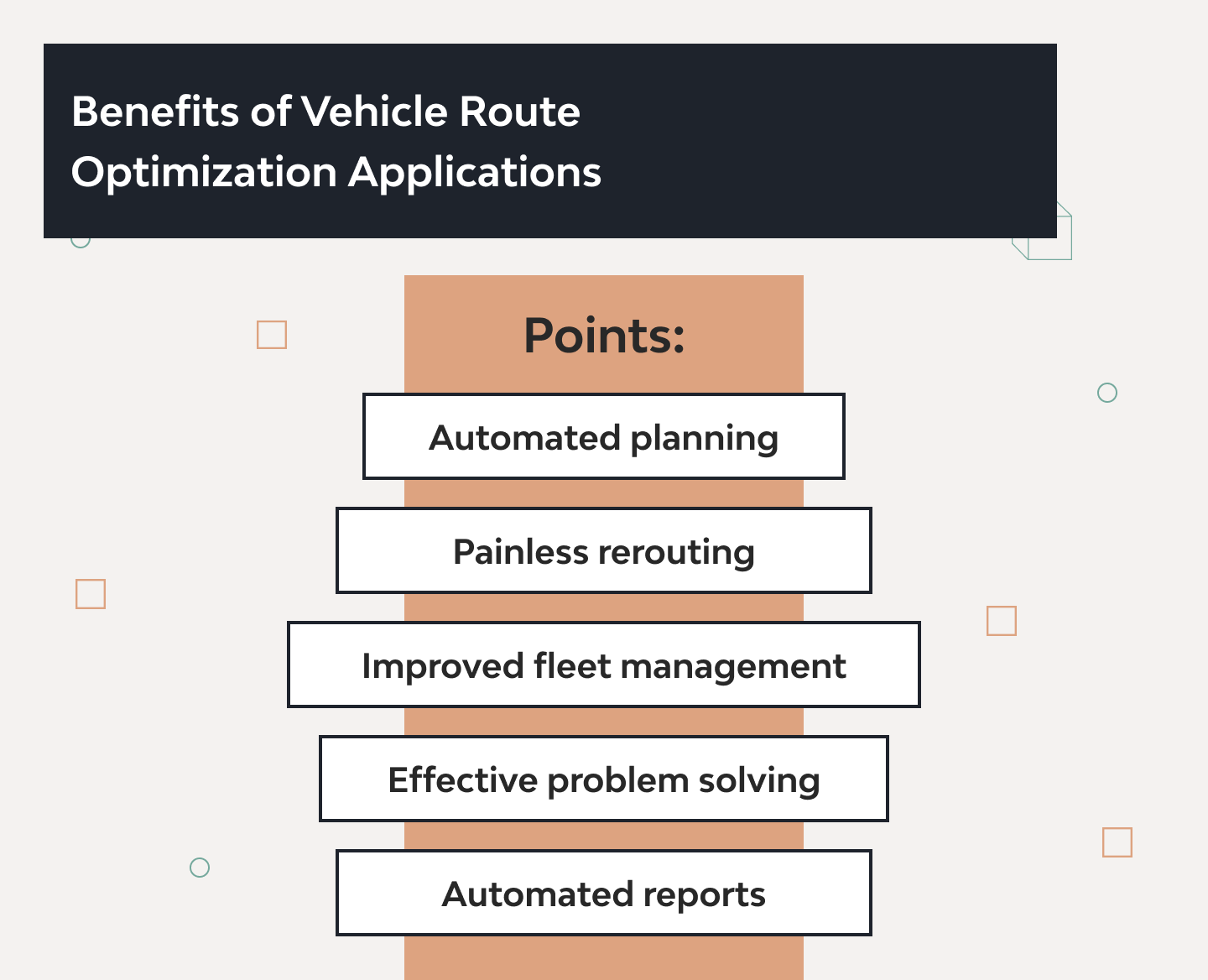
Steps to Take Before Developing and Integrating a Vehicle Route Optimization Solution
Building a transportation optimization solution starts long before planning the first designs or writing any code. Here’s what should be done before embarking on a development journey.
- Defining operational requirements. Companies should analyze their current logistics and delivery operations and define which business challenges and inefficiencies they need to address. Then, they must determine how a routing solution can improve operations and set clear goals and objectives (e.g., reduce delivery time, optimize resource allocation, and minimize fuel expenses).
- Assessing system compatibility. It’s important to determine if the software for transportation route optimization needs to integrate with other systems the business uses, such as administration, order, or warehouse management solutions. Companies should identify data exchange requirements to ensure the route-building solution seamlessly integrates with the existing infrastructure.
- Researching available solutions. Exploring vehicle routing software solutions on the market and reviewing their features, scalability, reputation, and customer reviews is essential. Vendors should offer demos or trial versions so businesses can assess the solutions’ performance, user interface, and analytics.
- Evaluating the software’s flexibility. Routing algorithms can process multiple criteria to build the most optimal routes. But there may be human factors that automation doesn’t consider (e.g., driver absence, accident, non-responding clients, etc.). The system should allow changes to routes and manually building new ones.
- Anticipating future growth. Businesses that expect to grow should consider whether the solution can scale. They must evaluate whether route optimization solutions will accommodate potential changes in fleet size, order volume, or geographic expansion.
If a business has unique requirements or specific integration needs, it may need to invest in custom route planning software development rather than adopt off-the-shelf software. This would require considering factors like development cost, timeframe, and finding an experienced logistics software development company.
Must-Have Features of Fleet Route Optimization Software
Route optimization software usually has two major components: a module for managers of administrators and a module for drivers. Let’s start by exploring the essential components an administrator application should have to manage a fleet effectively.
Real-time routing
According to Bloomberg, when FedEx adopted dynamic route optimization software, they improved workforce productivity and increased profitability for certain routes. Equipped with machine learning (ML) algorithms, the solution could evaluate routes, schedules, and stops to find the best combination and update navigation instructions in real-time.
Dynamic dispatching
Matching routes to drivers is another important feature of route optimization software. As new orders appear, dynamic dispatching assigns them to the most appropriate vehicle based on truck capacity, the proximity of stops, and other configurable criteria. This lets managers allocate resources efficiently and ensure that employees work the proper number of hours and don’t get burned out.
GPS tracking
Real-time GPS tracking of trucks provides visibility of the fleet’s location in real-time, so managers can monitor vehicle movement, track delivery progress, and make sure drivers comply with drive-time regulations. This technology typically involves integrating with telematics systems installed in the fleet vehicles or GPS capabilities of drivers’ devices (smartphones or tablets).
Delivery status
From May 2021 to April 2022, UK citizens reported 1,009 billion packages, costing around £33.6 billion, lost or stolen. A substantial part of the refunds to those customers fell on the shoulders of delivery companies, causing them to lose profits and customer loyalty.
Real-time updates on the status of each delivery, including its completion, delays, or exceptions, let fleet managers address issues as soon as they arise. So they can make necessary adjustments to delivery schedules to prevent parcels being left in unsecure places.
Territory management
Managers can assign drivers or vehicles to optimized routes within specific territories. Dividing a large geographical area into distinct territories or zones helps efficiently allocate workload and deliveries.
Inspection management
Vehicles break down in the most unexpected moments, threatening delivery schedules. An inspection tracker helps fleet managers monitor and manage vehicles’ condition and maintenance needs. This way, vehicles are always ready for deliveries and safe for drivers. A good inspection tracker has the following features:
- Pre-trip inspection checklist that drivers must complete before starting their routes
- Maintenance reminders based on mileage, engine hours, or time intervals
- Fault detection and reporting (when integrated with a vehicle’s onboard diagnostic systems or telematics devices)
All these help to enhance fleet safety and minimize delays due to breakdowns.
Cargo-type monitoring
Sometimes, specific types of cargo require specific routes or speeds. For example, some cargo might require specialized equipment, like refrigerated trucks; an extra-large load might have to move at a slower speed; or some cargo might require avoiding specific routes because the cargo contains hazardous material.
The system considers the compatibility of different cargo types, weight distribution, and special handling requirements to load trucks efficiently.
AI analytics
Software for transportation route optimization generates enormous amounts of data, which artificial intelligence (AI) analytics can turn into insights. By analyzing historical and real-time data (both structured and unstructured), AI can identify patterns, trends, and anomalies in transportation and distribution networks.
AI analytics track and monitor KPIs related to route optimization. By providing insights into metrics such as on-time delivery rates, route efficiency, fuel consumption, and driver performance, AI analytics can identify and react to problematic areas (e.g., send alerts and notifications), help optimize resource allocation, and enhance overall fleet performance to increase revenue and profit.
In addition to features designed for managers, a technology partner can incorporate a module or a separate application for drivers during vehicle-routing software development. Let’s look at features designed for drivers.
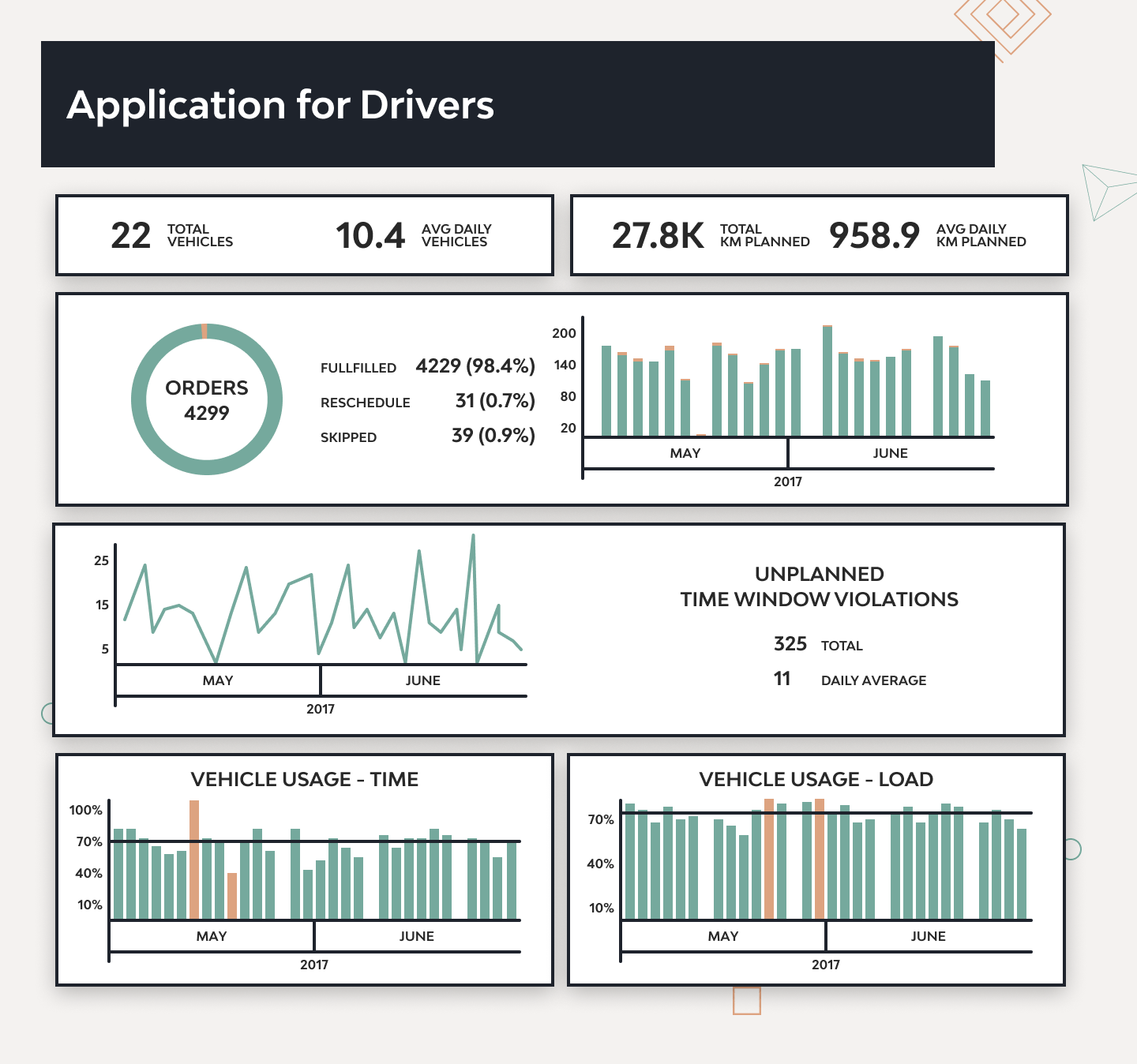
Route directions
Providing accurate and up-to-date directions eliminates the need to switch between apps and guides drivers along optimized routes. Integrating GPS navigation gives drivers turn-by-turn directions, real-time traffic updates, and alternative route suggestions.
Route optimization
Delivery route planning software should provide drivers with a clear understanding of the order of stops, delivery time windows, and any special instructions associated with each visit. This lets them follow the most efficient stop sequence, minimize mileage, and ensure on-time deliveries.
Informing clients
The software can integrate with communication channels such as SMS and email to send automated alerts to clients, letting them know how far away their delivery is. Drivers can update the system with delivery status, and the software will automatically send notifications to clients. So, clients get timely updates without requiring drivers to interact with them directly.
Hours-of-service (HOS) tracking
Developing a route planning software module for drivers will let them monitor their driving hours, rest periods, and adherence to work regulations. The module or app can also send alerts to notify drivers and fleet managers when they approach or exceed their allowed driving time limits.
Proof of delivery (POD)
With electronic POD, drivers can record delivery details on their tablets or smartphones. This includes
- Recording delivery timestamps
- Capturing recipient signatures
- Taking photos of delivered goods
Electronic POD eliminates tedious paperwork, enhances data accuracy, and streamlines sending delivery data back to the company.
Integrating Route Optimization with a Product
Route planning software development presents ample opportunities for businesses, even if the newly developed product doesn’t include all of the possible optimization features. Before pursuing development, businesses should prioritize which features will have the most impact. This will allow them to correctly assess the cost and the value the business will gain.
According to a 2020 Deloitte survey of nearly two hundred supply chain leaders (including trucking, ocean, and rail in manufacturing and retail), 81% of shipping companies either used or planned to use new data sources to get better insights, control, and visibility into their supply chain operations. Among their priorities were connected transportation, cargo, and traffic data.
Read Also: Connection Between Shippers and 3PL Providers

For instance, supply chain optimization software provided greater visibility into shipping the Pfizer vaccine to FedEx during the COVID-19 outbreak. The vaccine needed to be transported at a constant temperature of -75ºC. An IoT tracking device that monitored temperature and GPS location helped FedEx control distribution at the required temperatures and document proof of delivery.
UPS also enhanced its route building by developing ORION — an On-Road Integrated Optimization and Navigation algorithm — to quickly solve complex routing problems. It looks at over 200,000 alternatives before deciding on the best route for each driver based on the distance between stops, delivery time windows, vehicle state, and so on. At full deployment, ORION can reduce yearly driving by up to 100 million miles and save the company between $300 and $400 million annually.
However, an important question about route planning software development remains: How expensive is it?
How Much Does Developing a Transportation Routing Solution Cost?
The cost of developing a transportation routing solution can vary widely depending on many factors, including:
- Software complexity
- Feature set
- Development approach
- Technology stack
- Team size
- Developer location
All these factors make it challenging to name a price without specific project details. In a nutshell, the more complex the solution, integrations, and scalability requirements, the higher the cost of development.
Luckily, the cost of developing a fleet routing app can be reduced by applying the following strategies:
- Defining precise requirements and prioritizing essential features to avoid scope creep and unnecessary development that can drive costs up
- Using Agile development methodologies so developers focus on the most critical features first, which provides early value to users, and then incrementally add functionality
- Creating a minimum viable product (MVP) to launch the software quickly and gather user feedback to guide further development efforts
- Outsourcing development to an experienced logistics software development company from a country with more affordable rates
Django Stars can help you with all of these strategies.
Django Stars’ Experience
Django Stars has been building location-based apps since 2008. To demonstrate our experience, here are some route optimization software cases we’ve completed for clients.
Logistics company
A US intermediary logistics company chose Django Stars to develop a route planning app that would facilitate the company’s customer acquisition and logistics. The application, which is still under development and will be launched soon, will help the company :
- Accept orders
- Plan and track orders
- Adjust drivers’ work schedule
- Develop relevant routes
The application also includes a module that allows drivers to view and accept orders in real-time.
Corporate Food Delivery Service
A leading food delivery service in the US already had a working platform and a competent team of technical experts when they approached us. They wanted to extend their team with our highly skilled professionals to speed up further development.
They tasked our team with the following responsibilities:
- Contribute to architectural design
- Reinforce backend development
- Migrate Angular front-end app to React
Our software engineers both modernized legacy solutions and contributed technical innovation.
Azyan
Jordanian food delivery service Azyan reached out to us to build delivery planning software. They had a detailed product concept and needed an experienced team to bring their idea to life. We collaborated to develop client and driver apps with zone-based order distribution and dynamic routes.
The client application lets users view restaurant menus, order food, and track delivery status and driver location on the map. The driver app, in turn, allows drivers to accept or reject pickups, see optimized routes, and contact clients in case they need to clarify delivery details.
One of the biggest challenges we faced on this project was that Google Maps had not yet mapped addresses for the capital city of Amman at that time. This meant users couldn’t add their addresses directly. We leveraged map coordinates to ensure that users could still pin accurate location information and have a seamless experience.
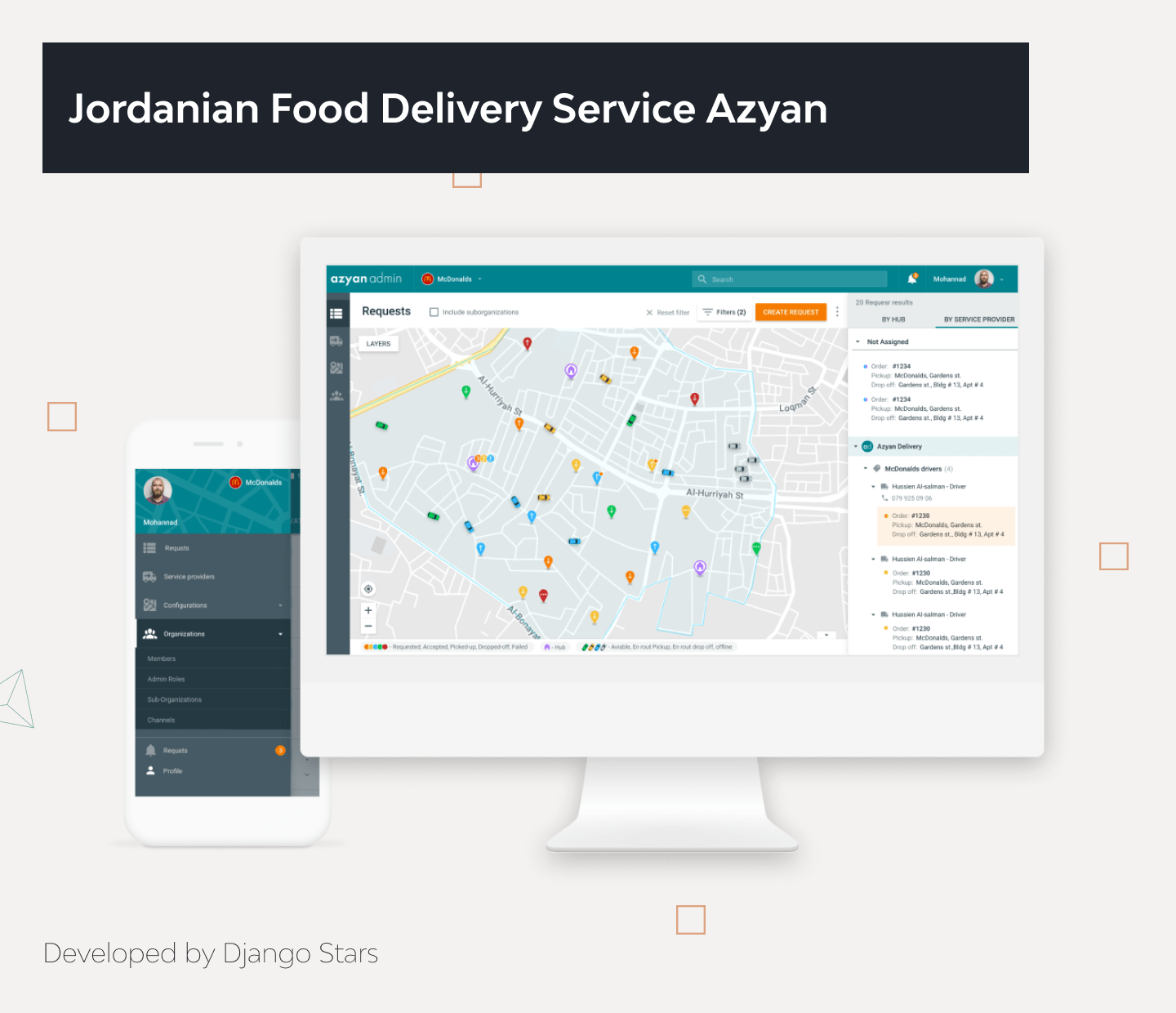
Conclusion
The constantly growing demand for faster, cheaper, and more environmentally friendly delivery pushes businesses to optimize their logistics processes and operations. Although reducing a company’s carbon footprint is difficult, custom vehicle routing software can play a part by enhancing transportation efficiency, and at the same time, it gives businesses a leg up on their competitors.
Empowered by automation and AI capabilities, delivery route planning software can analyze dozens of parameters to maximize operational efficiency, load, and fleet distribution. It gives delivery businesses control over their vehicles, including scheduling maintenance. It also keeps managers informed about vehicle locations in real-time, with instant updates on the delivery status and the ability to easily assign new orders based on a truck’s location, capacity, and schedule.
Our logistics case studies examples showcase that Django Stars can help build and integrate route optimization solutions that solve different kinds of transportation problems. Contact us to develop the best route optimization app that addresses all VRPs, improves customer experience, and increases profit.
- How long does it take to build a route-planning solution?
- Route optimization software development can take from six months to a year. Development time strongly depends on the product concept and required features.
- How can route optimization software expand and adapt as a business scales?
- To support business growth, route scheduling software should seamlessly integrate with other business systems and applications a business uses and be designed to accommodate an increasing number of vehicles, drivers, and orders as the company expands.
- How can transportation route optimization software enhance logistics processes?
- Custom vehicle route optimization solution solves numerous vehicle routing problems by ensuring efficient distribution and capacity utilization, which reduces fuel and maintenance costs.
- How much does it cost to develop route optimization software?
- The cost of developing a transportation routing solution depends on the complexity of the software, the feature set, the development approach, the tech stack, the team size, and the developers’ location.










